Die casting machine and Auto Extractor represents the core direction of the transformation of the precision casting field to automation and intelligence.
The synergy between the two not only significantly improves production efficiency and product quality, but also reduces safety risks by reducing manual intervention.
Despite challenges such as high temperature adaptability and cost control, through technological innovation and system optimization.
This convergence will continue to unleash the potential of automotive, electronics, home appliances.
And other industries to promote the efficient and sustainable development of the manufacturing industry.
What is hot chamber die casting machine
Hot chamber die casting machines are mainly used for the die casting of metals with low melting points.
Such as zinc, tin, and lead alloys, and are suitable for the production of small precision parts, such as electronic components or automotive parts.
The advantages of Haichen’s hot chamber die-casting machine are high efficiency, high degree of automation, continuous production process, no need for frequent scooping of molten metal, thus fast production speed and stable quality.
Auto Extractor is an automatic removal device in industry, such as in die casting machines.
Notably, the Automatic Extractor serves as the take-out device in the superheat chamber die casting machine, enabling seamless component removal and cycle time reduction.
Therefore, the combination here should refer to the integration of automatic take-out equipment on the hot chamber die-casting production line.
Technical advantages include increased production efficiency, reduced manual intervention, reduced labor intensity, and improved safety, while ensuring consistent casting quality.
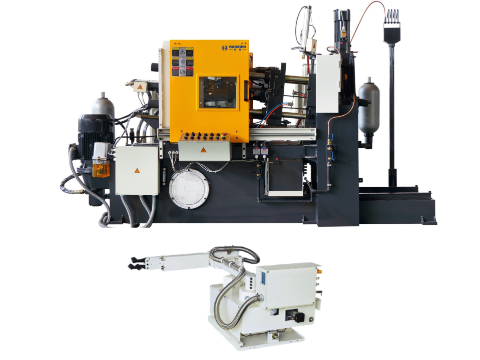
Hot chamber die casting machine
- Mold closing device
- Injection device
- Hydraulic transmission system
- Electrical control system
- Auxiliary system
The hot chamber die casting machine is a kind of high-efficiency casting equipment dedicated to low melting point alloys such as zinc, magnesium, lead alloys.
And its core principle is to inject molten metal into the mold cavity through pressure, and form precision castings after cooling and solidification.
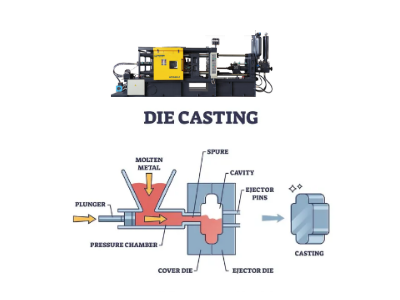
Mold closing device
It is responsible for the opening, closing and locking of the mold, and is composed of the shaping seat plate, the moving seat plate, the pull rod, the hydraulic cylinder, etc.
Modern models mostly adopt hydraulic or hydraulic-mechanical structures, and the clamping force can reach several thousand kilonewtons (kN).
The function is to ensure that the mold closes stably during the high-pressure injection process and prevent the leakage of the molten metal.
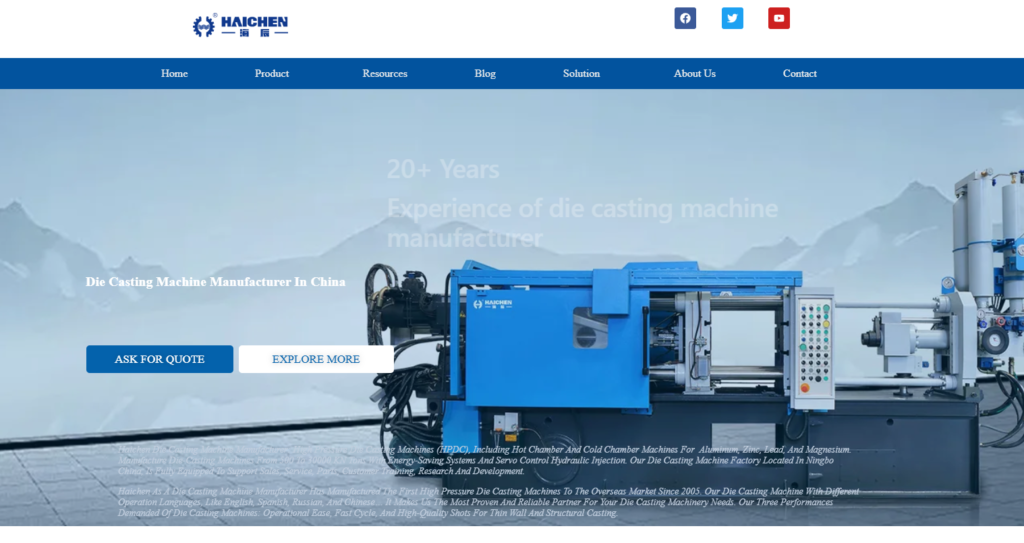
Injection device
It includes components such as the pressure chamber, hammer head, and nozzle.
The pressure chamber is directly immersed in the molten metal of the furnace.
And the molten metal is pushed to fill the mold at high speed by the vertically moving injection cylinder.
The speed can reach 5-8m/s, and the pressure can reach 40-150 mpa, thus achieving the forming of thin-walled complex parts.
Haichen‘s hot chamber die casting machine has optimized the injection system (such as dual-speed control) and nozzle heating device, enhancing filling efficiency and the surface quality of castings.
Hydraulic transmission system
By adopting multi-level pressure control and accumulator technology, smooth switching of actions such as mold closing, injection and ejection is achieved.
The system pressure is usually 10-21MPa, and it is equipped with low-noise high and low-pressure dual pumps to save energy.
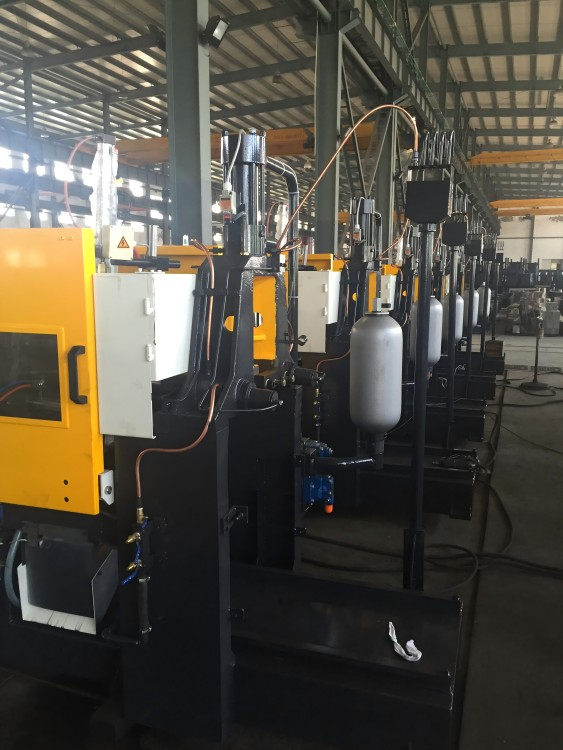
Electrical control system
Integrated PLC and touch screen, supporting multi-language interface and parameter preset such as injection speed, holding pressure time.
The haichen die-casting machine is equipped with a real-time monitoring module, which can record production data and issue early warnings for abnormalities.
Auxiliary system
Furnace: Fully automatic combustion furnace or electrically heated crucible, capacity 50-500dm³, temperature control accuracy ±5℃.
Cooling/lubrication system: The mold temperature is controlled by water cooling or oil cooling, and the central lubrication system reduces the wear of key components.
The implementation methods and technical advantages of the automatic pick-up system
- Mechanical arm and clamping device
- Core function
- Technical characteristics
- Drive and Control
- High precision and flexibility
- Intelligent upgrade
- Work process
- Part retrieval stage
- Technical advantage
The automatic part retrieval system works in coordination through mechanical arms, sensors and control systems to achieve full automation from the removal of castings from molds to subsequent processing.
Mechanical arm and clamping device
Structural type: Multi-joint six-axis robot (such as BRTIRUS1510A from Brant) or linear coordinate manipulator, load capacity 2-20kg, repeat positioning accuracy ±0.1mm.
Clamping design: Hydraulic or pneumatic grippers are adopted.
Haichen supports quick mold changing to adapt to different casting shapes.
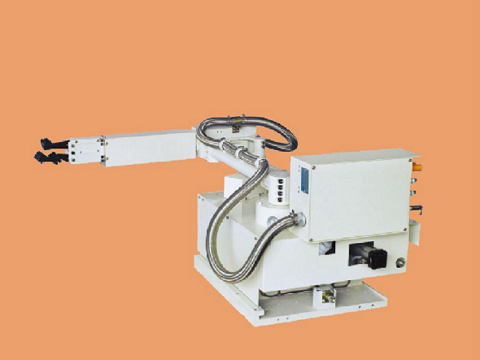
Core function
Automated part retrieval: Castings are removed from molds by mechanical arms or dedicated fixtures, replacing manual operations and avoiding the risks of high-temperature environments.
Integrated production: Linked with die-casting machines, spraying machines and edge cutting machines to form a fully automated production line.
Diversified modes: Supports upright picking (avoiding interference from oil tanks), and is compatible with multiple types of products (via replaceable fixtures).
Technical characteristics
Drive and Control: Motor drive enables high-speed component retrieval (shortening the cycle).
And the PLC control loop provides fault code display and maintenance convenience.
High precision and flexibility: Manufacturers such as SPESIMA offer 3-axis to 6-axis robotic arms, supporting non-destructive extraction of complex-shaped castings, with a repeat positioning accuracy of ±0.1mm.
Intelligent upgrade: Integrated visual inspection system to monitor the quality of castings in real time and sort out non-conforming products.
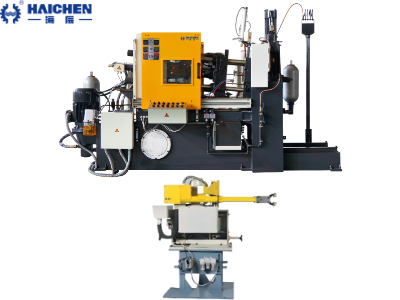
Drive and Control
Motor drive enables high-speed component retrieval (shortening the cycle), and the PLC control loop provides fault code display and maintenance convenience.
High precision and flexibility
Manufacturers such as SPESIMA offer 3-axis to 6-axis robotic arms, supporting non-destructive extraction of complex-shaped castings, with a repeat positioning accuracy of ±0.1mm.
Intelligent upgrade
Integrated visual inspection system to monitor the quality of castings in real time and sort out non-conforming products.
Work process
Inspection stage: Confirm that the mold opening is in place through the photoelectric sensor and trigger the part retrieval signal.
Part retrieval stage
The mechanical hand enters the mold area, clamps the casting and simultaneously completes the water outlet separation (some models integrate the spray function).
Post-processing: The castings are placed on the conveyor belt or edge cutting machine.
Some systems support online inspection and sorting.
Technical advantage
Efficiency improvement
The pick-up time is shortened to 3-8 seconds per item, which is 30%-50% more efficient than manual operation.
Quality Assurance
Avoid casting deformation or contamination caused by manual contact, and reduce the scrap rate by more than 20%.
Safety
Equipped with anti-collision sensors and emergency stop mechanisms to reduce the risk of work-related injuries.
Intelligentization
Connected to the die-casting machine for control, achieving synchronous production rhythm and self-diagnosis of faults.
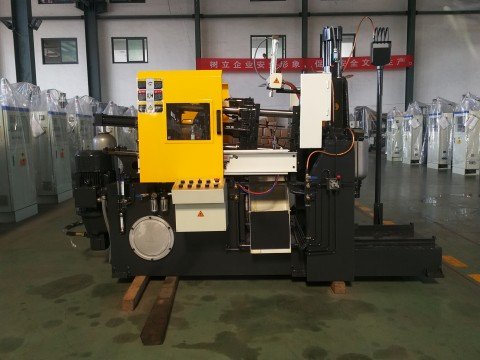
Collaborative optimization of Hot Chamber Die Casting Machine and Auto Extractor
- Process flow integration
- Efficiency improvement strategy
Process flow integration
Timing synchronization
After the die-casting machine completes the ejection action, the Auto Extractor immediately intervenes to pick up the parts.
Reducing the waiting time (for example, the JSED series shortens the cycle period through the standby mode).
Post-processing connection
The extractor can directly transfer the castings to the cooling table or edge cutting machine to achieve continuous production.
Efficiency improvement strategy
Vacuum casting technology
Applying a high vacuum process on a hot chamber die casting machine reduces porosity defects.
And increases the density of castings tests show that the tensile strength is enhanced by 6.2%.
Thermal coupling optimization
Optimize the thermal deformation of the injection mechanism.
Such as the fit clearance between the plunger and the pressure chamber through numerical simulation to extend the service life of the equipment.
Parameter intelligence
The microcomputer control system dynamically adjusts injection pressure and speed in real-time.
While simultaneously integrating digital twin technology to predict maintenance requirements.
Quality control measures
Closed-loop feedback: By monitoring parameters such as mold temperature and injection pressure through sensors.
The system automatically adjusts the process conditions , thereby ensuring consistency.
Material adaptability: Optimize the furnace temperature curve for different alloys (such as zinc and magnesium) to avoid oxidation or excessive thermal stress.

The advantages and challenges of automated systems
- Advantages
- Challenges and Solutions
Advantages
Efficiency improvement: The fully automated unit enables unmanned operation, reducing the cycle time by more than 30%.
Cost reduction: Reduced reliance on manual labor and low maintenance costs.
For example, Haichen equipment uses imported core components to ensure durability.
Quality stability: Mechanical parts removal avoids human errors, and the dimensional tolerance of castings is controlled within ±0.05mm.
Challenges and Solutions
Equipment compatibility
It is necessary to ensure that the interface of Auto Extractor is compatible with die-casting machines of different brands (such as ABB and FANUC robot system integration).
High-temperature environment adaptability
The robotic arm needs to adopt high-temperature resistant materials.
Such as ceramic coatings and cooling designs to extend its service life.
Production application cases
- Automobile parts production
- Manufacturing of electronic components
- Daily-use hardware and household appliances
Automobile parts production
Application scenarios: Hot chamber die-casting machines are used to manufacture zinc alloy automotive parts (such as door locks and sensor housings).
The Auto Extractor automatically removes the castings through the mechanical arm and feeds them into the edging machine or inspection station.
For instance, a certain die-casting enterprise has shortened the production cycle by 20% and reduced the scrap rate to below 2% by integrating an automatic extraction device.
Manufacturing of electronic components
Application scenario: When manufacturing thin-walled precision castings such as laptop casings and connectors.
Auto Extractor ensures that the castings are removed undamaged through vacuum suction cups or flexible fixtures.
And simultaneously conducts real-time quality inspection in coordination with the vision system.
Technical highlights: Some high-end equipment such as Prolean hot chamber die casting machines integrate AI algorithms.
Which can dynamically adjust the extraction path to deal with minor mold deformations, further improving the yield rate.
Daily-use hardware and household appliances
Application scenarios: In the production of zinc alloy castings such as faucets and rice cooker casings.
Auto Extractor is linked with hot chamber die-casting machines to achieve a fully automated process of “die-casting – removal – cooling – packaging”, significantly reducing labor costs.



